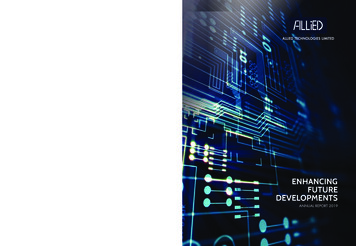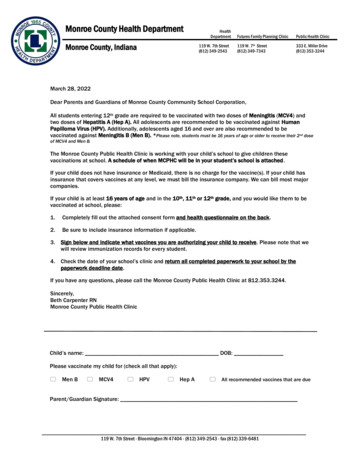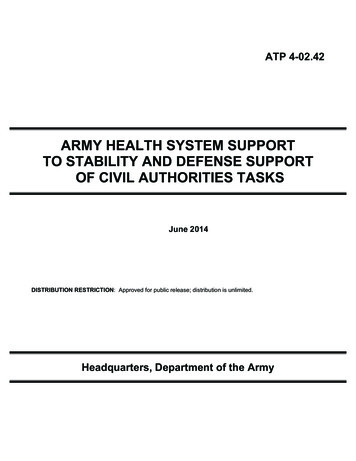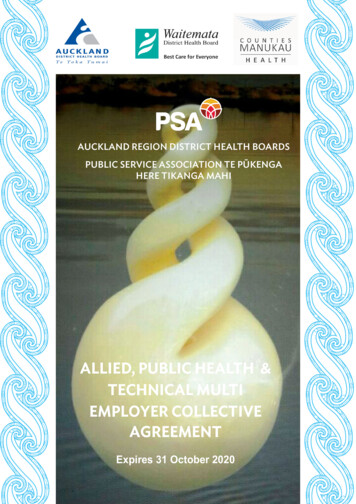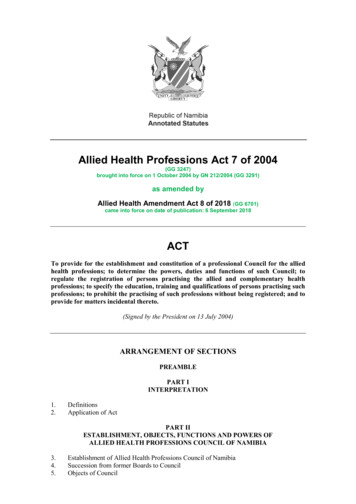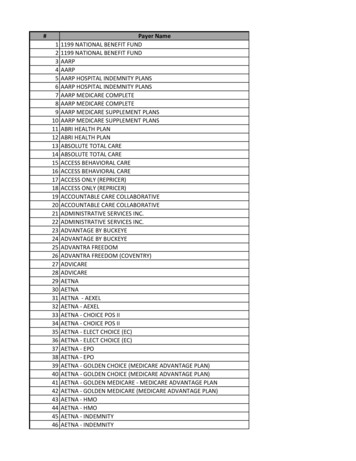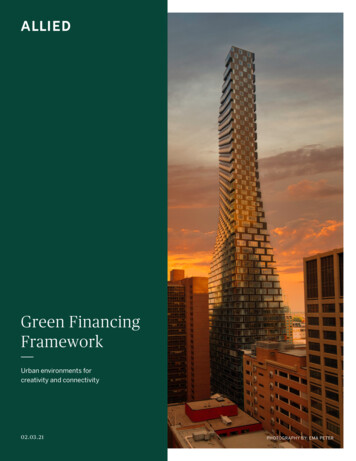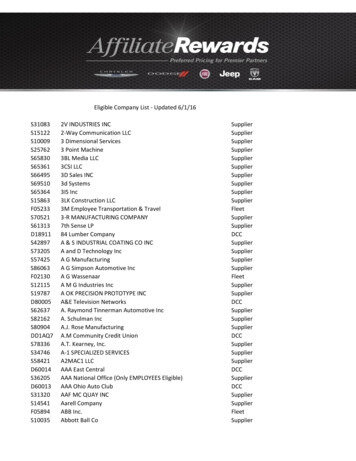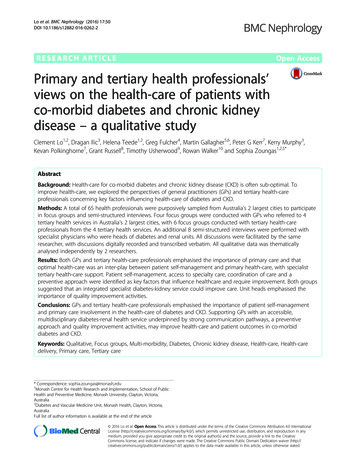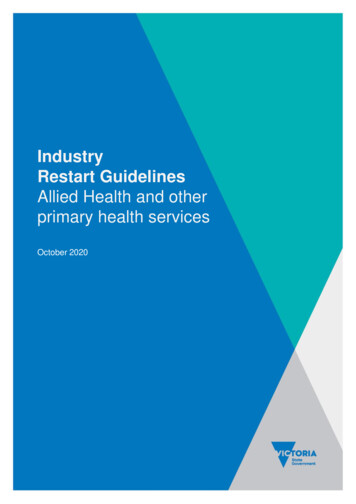
Transcription
IndustryRestart GuidelinesAllied Health and otherprimary health servicesOctober 2020
Victoria’s roadmap: Allied Health and other primaryhealth servicesOn 6 September, the Victorian Government announced Victoria’s roadmap for reopening whichoutlines considered and gradual steps to ensure that businesses can open safely and effectively.As many Victorian businesses reopen, the priority will be the health and safety of workers and customers.The industry roadmap includes four steps to easing restrictions and reopening businesses. These steps will be subject totrigger points determined by our public health team and will be based on case numbers, testing numbers and other factors. The trigger points mean that metropolitan Melbourne and regional Victoria will take steps (and move to associatedrestriction levels) at different times. Each industry will also have a different restriction level depending on which step metropolitan Melbourne or RegionalVictoria is in.The below Allied Health and other primary health services Roadmap is intended to assist workplaces to prepare to safelyoperate in accordance with the easing of restrictions, while also ensuring the public feels confident that their health andsafety is being protected. This includes all allied health or primary health care private practice or primary care workplaces(but not including practices specific to general practitioners, community pharmacy, nursing and midwifery).The current restriction levels for metropolitan Melbourne and regional Victoria are highlighted in the below roadmap.Metro MelbourneRegional VictoriaRestrictedTelehealth servicespreferred and densityquotient applies. Indoorgroup classes permitted.First StepMetropolitan Melbourne - First Step commencedfrom 11.59pm on 13 SeptemberHeavily restricted.For permitted purposes only.SecondStepMetropolitan Melbourne – Move to the SecondStep from 11:59pm on 27 September 2020.Further easing of restrictions from 11:59pm on 18October 2020.RestrictedAllied health providers on thePermitted Work Premises Listmay return for full face-toface routine care. Telehealthremains preferred andindoor classes are not allowed.Regional Victoria – Moved to Second Step from11.59pm on 13 September 2020ThirdStepMetropolitan Melbourne: Move to the Third Stepsubject to public health assessment ofepidemiological conditions.Restricted.Telehealth services preferredand density quotient applies. Noindoor group classes.RestrictedTelehealth servicespreferred and densityquotient applies. Indoorgroup classes permitted.Regional Victoria: Moved to Third Step from11.59pm on 16 September 2020Last StepRegional Victoria and metropolitan Melbourne:Move to Last Step subject to public healthassessment of epidemiological conditions.RestrictedTelehealth services preferredand density quotient applies.Indoor group classes permitted.RestrictedTelehealth servicespreferred and densityquotient applies. Indoorgroup classes permitted.COVIDNormalRegional Victoria and metropolitan Melbourne:Move to COVID Normal subject to public healthassessment of epidemiological conditions.Open with a COVIDSafe Plan.Record keeping requirements.No density quotient.Open with a COVIDSafePlan. Record keepingrequirements. No densityquotient.Status as at 11.59pm on 18 OctoberFor the latest information on restrictions in Victoria, ction-levels-covid-19
Sector guidelines for reopeningCurrent restrictions on Allied Health and other primaryhealth servicesAll businesses need to know their obligations and ensure they have an understanding of the currentrestrictions in place throughout Victoria.Under directions issued under the Public Health and Wellbeing Act 2008, all allied health and other primary health businessesmust abide by the following restrictions in both metropolitan Melbourne and regional Victoria respectively, effective from 11.59pm18 October.These restrictions apply to all private and primary care allied health providers including but not limited to: audiology, chiropractic,dietetics, exercise physiology, medical radiations (radiography, nuclear medicine and radiation therapy), occupational therapy,optometry, orthoptics, orthotics/prosthetics, osteopathy, pharmacy, physiotherapy, podiatry, psychology, social work and speechpathology. Additionally, the restrictions also apply to other primary health services such as myotherapy, remedial massage,naturopathy and kinesiology.\Requirements fortelehealth servicesMetro MelbourneRegional VictoriaRESTRICTEDRESTRICTED Telehealth services must bepreferred as the first option forcare delivery and providedwhere and as appropriate. Most face-to-face clinicalservices providedwith COVIDSafe Plan in place(except for indoor group classesas below). Requirements forclinical servicesTelehealth services must be preferred as the first option for care deliveryand provided where and as appropriate.Allied health providers on the Permitted Work Premises List may returnfor full routine care.Allied health providers on the Permitted Work Premises List may return forfull face-to-face routine care. Telehealth remains preferred and indoorclasses are not allowed.All AHPRA registered health workers - and in addition, social work, speechpathology, dietetics, audiology, exercise physiology, orthotists andprosthetists and those providing orthoptics, art therapy and music therapymay provide routine and preventative care for individual patients.Any other health worker providing services required under a ChronicDisease Management Plan, a care plan endorsed by NDIS (including selfmanaged plans), TAC, Workcover or DVA - if care is required to prevent asignificant change/deterioration in functional independence necessitatingescalation of care (e.g. an increase in frequency of treatment needed, anincreased need for prescription medication due to a significant increase inpain, requirement for specialist input or review, an increase in care needs,and/or a substantial increase to anticipated recovery time associated with adelay in receiving services).No group classes / services to be provided (face-to-face) unless the sessioncan be conducted safely outdoors (maximum 2 people plus health worker).Last updated: 18 October 2020For additional information and FAQs, ce
Sector guidelines for reopeningCurrent restrictions on Allied Health and other primaryhealth servicesAll businesses need to know their obligations and ensure they have an understanding of the currentrestrictions in place throughout Victoria.Under directions issued under the Public Health and Wellbeing Act, all allied health and other primary health businessesmust abide by the following restrictions in both metropolitan Melbourne and regional Victoria respectively, effective from 11.59pm18 October.These restrictions apply to all private and primary care allied health providers such as: audiology, chiropractic, dietetics, exercisephysiology, medical radiations (radiography, nuclear medicine and radiation therapy), occupational therapy, optometry,orthotics/prosthetics, osteopathy, pharmacy, physiotherapy, podiatry, psychology, social work and speech pathology. And inaddition other primary health services such as: Myotherapy, remedial massage, naturopathy, kinesiology.\Group classes forpurpose of clinicalintervention onlyMetro MelbourneRegional VictoriaRESTRICTEDRESTRICTED No indoor group classes / services to beprovidedOutdoor sessions may be conducted whereappropriate with a maximum two people plushealth worker.Re-opening of indoor pools for one-on-onehydrotherapy sessions with health professionalswhere clinically indicatedIndoor group classes may only be provided for clinicalinterventions: to prevent a significant deterioration in functionalindependence which would result in an escalation ofcare needs (such as increased frequency in treatment,significant increase in pain, specialist input, orsubstantial increase in recovery time as a result ofdelayed care) to provide essential pre-operative or post-operativeelective surgery care Re-opening of indoor pools for one-on-onehydrotherapy sessions with health professionals whereclinically indicated, limited to the lesser of 10 people orthe density quotientStaff should work from home if possibleApply density quotient of one person per fourmetres squaredno carpooling to work All workers must wear face masks (exceptionsapply) and additional PPE where required.Ensure adequate PPE training and supply Auditing of cleaning schedulesShared spaces and spaces open to members ofthe public at any Work Premises must be cleanedregularly, including twice a day for frequentlytouched surfacesCleaning of equipment and surfaces must occurin between each patient / client Ask staff to declare verbally before each shift thatare free of symptoms. Physical distancingrequirements Face maskrequirements Cleaningrequirements Record keepingrequirementsSignagerequirementsWorkforce bubbles Display signage at each public entry to eachspace indicating maximum number of membersof the public that may be present in the space ata single timeEmployer must not require a worker to work atmore than one work site of the employer, unless itis not practical to do so. The system to minimisethis must be demonstrated (e.g. rosters) Some staff should work from home if possibleapply density quotient of one person per four metressquaredAvoid carpooling where possibleAll workers must wear face masks (exceptions apply)and additional PPE where required.Ensure adequate PPE training and supplyAuditing of cleaning schedulesShared spaces and spaces open to members of thepublic at any Work Premises must be cleanedregularly, including twice a day for frequently touchedsurfacesCleaning of equipment and surfaces must occur inbetween each patient / clientAsk staff to declare verbally before each shift that arefree of symptomsDisplay signage at each public entry to each spaceindicating maximum number of members of the publicthat may be present in the space at a single timeEmployer must not require a worker to work at morethan one work site of the employer, unless it is notpractical to do so. The system to minimise this mustbe demonstrated (e.g. rosters)Last updated: 18 October 2020For additional information and FAQs, ce
guidelinesfor reopeningSixSectorCOVIDSafePrinciplesAll work premises must have a COVIDSafe Plan (see Creating a COVIDSafe Plan). A COVIDSafe Planapplies the six COVIDSafe Principles and sets out actions to help prevent the introduction of coronavirus(COVID-19) in the workplace. Display COVIDSafe signage in appropriate, high visibility locations.1. Ensure physical distancingAll people in the workplace should be at least 1.5 metres apart and there should be no overcrowdedareas. This means: Workers should work from home if possible Ensure workers and customers are at least 1.5 metres apart at all times. Where this is notpossible, the duration of the close contact should be minimised and additional precautionsshould be put in place Ensure the workplace abides by the four square metre rule density quotient Limit the total number of workers and customers in an enclosed area No carpooling between workers unless there is no alternative mode of transport to work2. Wear a face maskWorkers and customers must always wear a face mask except when eating and drinking, exercising,or health or other exemptions apply. This means: Provide face masks to workers throughout the shift Ensure all workers wear face masks while working Do not take face masks off when talking on the phone or with others Use full personal protective equipment (PPE) for high-risk settings3. Practise good hygieneOperators must regularly clean high touch-surfaces and encourage good hygiene practices byworkers and customers. This means: Schedule regular cleaning and disinfecting of high-touch surfaces(including all surfaces and handrails) and make gloves available for this purpose Encourage regular handwashing by workers and customers and make soap andhand sanitiser available for all workers and customers throughout the workplace4. Keep records and act quickly if workers become unwellHave a strict policy that any workers who feel unwell must stay at home. This means: Support workers to stay home and get tested even if they only have mild symptoms. Have a plan to immediately close down for cleaning and contact tracing if there is a confirmedcase of coronavirus (COVID-19) Keep records of worker and customer details for contact tracing5. Avoid interactions in enclosed spacesAll activities are to be held in outside areas which don't have a roof or ceiling, where practical. Thisincludes; Meetings Lunch breaks Customer registration6. Create workforce bubblesLimit the number of people that workers have prolonged close contact with. This means: Keep groups of workers rostered on the same shifts at a single worksite and ensure there is nooverlap of workers during shift changes Maintain records of all workers who have disclosed that they reside with another worker andensure that there is no cross-over between shifts Limit or cease the number of workers working across multiple work sites
Creating a COVIDSafe workplace:Allied Health and Primary CareAll Allied Health and other primary health workplaces must ensure they apply the six COVIDSafePrinciples to help prevent the introduction of coronavirus (COVID-19) in the workplace.Workplaces included: Private practice and primary care health services such as a physiotherapy,podiatry or myotherapy practice. Please note, these guidelines are not specific to general practice,community pharmacy or nursing and midwifery practice.Cleaning anddisinfecting scheduleImplement and displaya cleaning schedule soit is easily accessible to workersDensity quotient of one personper four square metres appliesfor people in common areas (e.g.lunchrooms)Workers must wear aface mask andadditional PPE whereappropriateAir conditioner setto optimum airflow at the start ofeach work dayHand sanitisermade availablein all spacesFloor markings toreinforcephysical distancingClean all equipment andsurfaces after each userFor the latest information on restrictions in Victoria, ction-levels-covid-19Record keepingat entrance forclients to complete
1. Ensure physical distancingPhysical distancing remains one of the most effective ways of minimising thespread of coronavirus COVID-19 and is a vital part of creating a safe workingenvironment.Employers should implement physical distancing measures to create a COVIDSafe workplace.This means keeping a minimum distance of 1.5m between workers and visitors.Ensuring physical distancing between workersStaff breaksImplement virtual meetingsSpread out staff break times to reduce thenumber of people using communal facilitiesat the same time.Workers meetings and trainings shouldbe held virtually or in areas that allow forappropriate physical distancing between staff.Minimise contactInstall screens or barriersRemoving excess chairs and tables fromcommunal break areas to encourage staffto stay a minimum 1.5 metres from one another.Close non-essential communal areas that do notallow for physical distancing.Where 1.5m distancing between workers is notpossible, install screens or plastic strip curtainswhere practicable to minimise the risk of droplettransmission from one employee to another.Screens need to be high enough to preventpotential droplets from coughing or sneezingdirectly reaching other employees.Discourage carpoolingStaff should not carpool to work unless there are noalternative options. Employers should discouragecarpooling and where possible, assist staff to findalternate transport options
Industry Guidance: Hospitality2. Wear a face maskYou and your staff must wear a face mask at work, and to and from work,unless you have a lawful reason for not doing so.Employers must ensure employees wear a face mask while at work, unless an exemption applies.A face mask includes a fitted face mask that covers the nose and mouth to provide the wearer protectionagainst infection. Face shields on their own do not meet these requirements. Please refer to the Departmentof Health and Human Services’ guidelines for further information.Employers should encourage their workers to bring their own face mask where possible, howeverthere is an obligation for employers to provide a face mask if a worker does not have one. Where the work ortask requires the use of specific types of face masks in the workplace, these must be provided by theemployer. Where a worker seeks to provide and use their own face mask at work, an employer must ensurethat it is meeting its obligations under the current Public Health Directions and the OHS legislative framework.Employers have a responsibility to identify whether there is a risk to the health of employees fromexposure to coronavirus (COVID-19) at their workplace.Employers and workers have legal duties under the Occupational Health and Safety Act 2004.See WorkSafe Victoria for information about minimising health risks in your workplace.Wearing a face mask in the workplaceResponsibility for wearinga face maskResponsibility for wearing a face mask rests withthe individual. Employers must take reasonablesteps to ensure their employeeswear a face mask at all times when workingat the employer’s premises, unless a lawfulexception applies.Workers wearing face masksWorkers must wear a face mask at all times whileon the premises, except in order to consume foodor drink. Workers do not need face masks whileeating or drinking.When can workers remove their facemask?Workers must wear their face mask at all timesunless they are eating or drinking (or if a lawfulexemption applies). However if the worker enters acommunal space or takes a break from the meal(for e.g. to use the facilities or to step outside totake a call), then the face mask must be worn.For more information about wearing a face mask, 19Sole tradersIf a worker is working alone in an enclosed space(like an office) the workers does not need to wear aface mask, but the worker must carry it with them.Removing face masks to communicateA face mask may be removed where a worker iscommunicating with another person who is deaf orhard of hearing, and / or the ability to see the mouthis essential for communication and treatment. Youshould maintain physical distancing of at least 1.5metres.Provide training on how to use PPEProvide all workers with trainings/guidance on how touse PPE (e.g. masks, face shields, gloves, etc) whileundertaking work tasks and socialising during breaks.
Industry Guidance: Hospitality3. Practise good hygieneAdditional hygiene measures are a priority. All Managers / Owners should review theseguidelines to maintain good hygiene in their premises, and document hygiene practises intheir COVIDSafe plan.Health and hygiene go hand in hand. To ensure the safety and wellbeing of your staff, business owners areencouraged to refer to WorkSafe Victoria, ‘How employers can use occupational health and safety (OHS)practice to plan for a pandemic’.The Public Health and Wellbeing Regulations 2009 set out the requirements for businesses registered underthe Act. Proprietors and staff should be familiar with the Australian Standards as they relate to their premisesand businesses.Workplace cleaning and disinfectingEducate customers and staffUndertake initial pre-opening deep cleaning andimplement an environmental cleaning schedule toensure frequent cleaning and disinfection of hightouch surfaces and bathrooms.Further advice about cleaning can be found here.Display posters on good hygiene and handwashingpractices in prominent places and establishhygiene stations (with hand sanitiser) at entrancesand throughout the office to encourage handhygiene of workers, visitors and clients.Cleaning and disinfecting scheduleFree infection control trainingEnsure surfaces are cleaned regularly, and hightouch surfaces cleaned at least twice on each givenday.Free, short, accredited training is available to helpstaff identify and manage the ongoing risk ofcoronavirus (COVID-19) infections in theworkplace.All surfaces and equipment should be wiped downin between seeing clients / patients.Accessible cleaning productsand disinfectantsMake cleaning products available near commonlyused surfaces where possible (e.g. placing handsanitiser in all treatment spaces, near theprinter/copiers, on tables and chairs, and inbathrooms).Free infection control training will help businessesprepare to safely reopen and ensure theircustomers and workforce are protected.Hygiene tips for workers Stay home if you are sick. Wash your hands often with soap andwater or alcohol-based hand sanitiser. Wash or sanitise hands after makingor receiving deliveries. Sneeze and cough into your sleeve. If you use a tissue, discard immediatelyand wash your hands afterward. Avoid touching your eyes, nose or mouth. Avoid contact with people who are sick. Avoid high-touch areas, where possible,or ensure you clean your hands after. If you are required to wear gloves do nottouch your face with gloved hands.Take care when removing gloves. Ensureyou wash your hands after removing them. Wash your clothes as soon as you get home.Workplaces should regularly check that they are complying withcurrent directions and advice provided by health authorities.
Industry Guidance: physical recreation4. Keep records and act quickly if workersor customers become unwellAll businesses must keep records of every person who attends the workplace andshould have a response plan, as part of their COVIDSafe Plan, ready for the possibilityof a person with coronavirus (COVID-19) at their premises.Workplace attendance registerUnder current public health advice, all Victorianworkplaces are required to establish andmaintain a ‘workplace attendance register’ (seeexample here) of every person who attends theworkplace for a period of more than 15 minutes.This includes all workers (including subcontractors) and any customers or visitorspermitted in the workplace (including workplaceinspectors).If a worker or customer tests positivefor coronavirus (COVID-19), a current andaccurate workplace attendance register willallow the employer to immediately identifyanyone who has been in close contact with thatperson within the 48 hours prior to the onset oftheir symptoms.For more information regarding the definitionof a close-contact, see: DHHS coronavirus(COVID-19) InformationIf a customer or workerwho is a confirmed case ofcoronavirus (COVID-19) hasattended your business whilethey are infectious, you must: Undertake a risk assessmentYou must undertake a risk assessment to help determinewhat actions are required. This may include closing partor all of the work premises to allow a comprehensiveclean, as well as the identification and notificationof close contacts.For more information see the Workplace guidance formanaging suspected and confirmed cases (including riskassessment template). Contact DHHS and WorkSafe Notify DHHS of the case as per theEmployer obligations in the Workplace Directions,providing it with your workplace attendance registers. Consult with DHHS on whether the business isrequired to stay closed for a short period to facilitatecleaning and enable contact tracing. Report the case to WorkSafe Determine hot spots Determine what areas of the business werevisited, used or impacted by the persons withcoronavirus (COVID-19). Clean the premises Close the affected area to prevent access prior to andduring cleaning and disinfection. Consider engaging suitably qualified personnel toclean and disinfect the area. Open doors and windows to increaseair circulation. The workplace should be thoroughly cleaned anddisinfected before it can be reopened and workerscan return to work.For more information, see How to clean and disinfectafter a COVID-19 case in non-healthcare settings
Industry Guidance: physical recreation4. Keep records and act quickly if workersor customers become unwell – continuedAll businesses must keep records of every person who attends the workplace andshould have a response plan, as part of their COVIDSafe plan, ready for the possibilityof a person with coronavirus (COVID-19) at their premises.Next steps: Slowing the spreadDHHS actionsContingency plansThe Department of Health and Human Services(DHHS) will liaise with operators where someonehas been at the business while infectious withcoronavirus (COVID-19). DHHS may requestinformation from the operator to assist with contacttracing. DHHS may also request the operatorto assist with contact tracing. DHHS will contactanyone who is identified as a close contactof the case.If multiple workers are directed to be quarantinedand this affects operational capacity, the businesswill need to consider its own contingency plansfor disposing of raw materials (especially freshingredients), any work in progress, or shortshelf-life stock to ensure food safety is maintained.Business actionsWork with DHHS to ensure that all appropriatepreventative measures have been taken priorto reopening the business.Provide DHHS with a list of the customers, workersand other visitors (e.g. contractors, deliveryworkers) who may be close or casual contacts.Employers must keep a record of all workers andvisitors who attend the workplace for longer than 15minutes over the past 28 days.Any worker who tests positive for coronavirus(COVID-19) should remain in home isolation untilthey have been notified by DHHS that they are nolonger required to self-isolate and have met itscriteria for release. The worker should follow DHHSguidance and their employer’s policy.Close contactsWorkers who are determined by DHHS as closecontacts of a person with coronavirus (COVID-19)must quarantine and should not come to work for14 days after their last close contact with theconfirmed case. They should watch for symptomsand seek medical assessment and testing if theybecome symptomatic.A note on privacyPlease respect the privacy of people witha confirmed case of coronavirus (COVID-19)and treat their condition with understanding andcompassion. If a worker is quarantining, check inon their wellbeing regularly and monitor theirmental health.Additional resourcesWorkers who have been required to self-quarantineafter a coronavirus (COVID-19) test may be eligibleto receive a one-off payment of 450 from theVictorian Government. Workers who are confirmedas coronavirus (COVID-19) positive may be eligibleto receive a one-off 1500 payment fromCommonwealth Government’s Pandemic LeaveDisaster Payment for Victoria. Further informationon coronavirus-related pay and leave entitlementscan be found through the Fair Work Ombudsmanat: Pay and Leave During CoronavirusHealth and Safety in the Workplace DuringCoronavirus
Industry Guidance: Hospitality5. Avoid interactions in enclosed spacesIn Victoria, employers have OHS duties and obligations to do what is reasonablypracticable to provide and maintain a working environment that is safe and withoutrisks to the health of employees.As part of creating a safe working environment that addresses risks associated with potential exposure tocoronavirus (COVID-19), businesses should have a have a plan in place to minimise the amount ofinteractions in enclosed spaces and maximise ventilation, air quality and use of outdoor spaces.This means, wherever possible, moving activities outside or to well-ventilated areas and keeping doors andwindows open as practicable to ensure maximum ventilation. Where activity cannot be moved outdoors,heating, ventilation and air-conditioning (HVAC) systems may have a role in decreasing the risk oftransmissions in indoor spaces by increasing the rate of air change, decreasing recirculation and increasingthe use of outdoor air.Actions your business can takeAir quality and ventilationConsider steps to improve ventilationOpen windows and outside doors where possibleto maximise ventilation. Use air conditioningto enhance the flow of air, however ensure that youare not using the ‘recirculate’ mode.Work with your building owner or manager toimprove ventilation in the private practice orprimary care setting. Measures include increasingthe percentage of outdoor air and disablingdemand-control ventilation (DCV) controls thatreduce air supply based on temperature oroccupancy.Air quality when cleaningOpen outside doors and windows to increase aircirculation before commencing cleaning anddisinfection. Keep doors and windows open aftercleaning and disinfection to allow the cleaningagents to disperse in the airflow.Move meetings and functions outsideWhere possible, move internal meeting andactivities to an outdoor area. Encourage workers totake their lunch breaks and any other breaksoutdoors as well.
Industry Guidance: Hospitality6. Create workforce bubblesHaving ‘workforce bubbles’ can help minimise the risk of infection and support contacttracing initiatives.A ‘workforce bubble’ is a group of workers who limit their in-person interactions to other members of thegroup. This strategy focuses on reducing the number of individuals a worker comes into contact with, ratherthan the number of interactions. Should a worker test positive or have symptoms of coronavirus (COVID-19),it will contain the spread to a minimum number of people within the bubble, rather than requiring the wholeworkforce to undergo quarantine.To minimise possible exposure and contact,businesses should:Limitthe number of people that staff have prolonged close contact withModifyprocesses to minimise interactions between staff members during breaksor when transitioning into or out of work periods where possibleConsultwit
Allied health providers on the Permitted Work Premises List may return for full routine care. Telehealth services must be preferred as the first option for care delivery and provided where and as appropriate. Requirements for clinical services Allied health providers on the Permitted Work Premises List may return for
